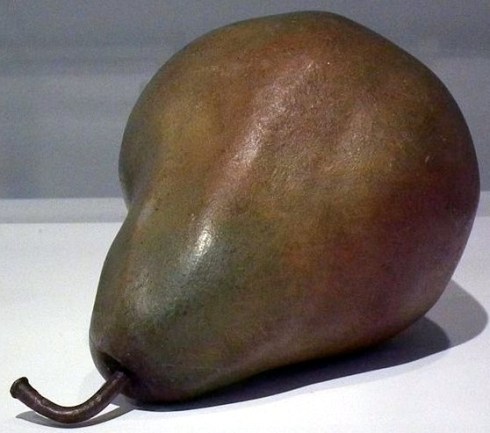I had a pear-oriented day yesterday. I was trying to work on the syllabus for my upcoming graduate course on Elizabethan England as well as the three-semester schedule for our department’s course offerings. Both are rather tedious tasks so I was taking regular breaks and roaming (both digitally and literally) away for bouts of time. I always like to have an “inspirational image” on my syllabi, and under the pretense of looking for one I spent hours examining Elizabethan portraits. Hours. Who is this, where are they, what are they holding, why are they dressed that way? Then I would feel guilty and go back to the syllabus and the schedule. Then I would take another break and go outside and see what’s popped up in my garden, ride my bike, play with my cats, and come inside and scope out lots in upcoming auctions, between loads of laundry and stabs at my syllabus and schedule. So you see the rhythm of my day, and by the end of this day of searching for Elizabethan images and secreting away from my schedule I ended up fixated on a pair of pears (or two pairs of pears really).


Anonymous follow of William Larkin, Three Young Girls, c. 1620, Berger Collection, Denver Art Museum; Donald Sultan, Pears screenprint from Fruit, Flowers and a Fish, 1989-91, published by Parasol Press, Ltd., New York, Skinner Auctions.
The painting of the three girls is not even Elizabethan–it dates from a bit later. But look at these girls, so beautiful and so ready, but for what? To greet an eminent visitor? To assume command of the household upon the death of their mother? The ripe fruit held by the older two might represent their maturity (and fecundity) while the younger girl is still “playing” with dolls–is this one a representation of Queen Elizabeth? I’m quite preoccupied with this painting: apparently lots of research remains to be done on both its projection(s) and its painter. Sultan’s pears appeal to me aesthetically, though I don’t have any questions about them (such is my reaction to much modern art). In their craftsmanship and detail they do, however, remind me of a very famous Salem pear: Samuel McIntire’s carving of an exemplar pear grown in Ipswich first captured by his contemporary, artist Michele Felice Corné.

Pear model by Samuel McIntire, 1802-1811, after a painting by Michele Felice Corné, Peabody Essex Museum, Salem.
I don’t feel like I have to draw Salem connections to every topic I write about here, but sometimes I can’t help it! Salem actually plays a very big role in pomological history as it prospered at a time when pears were much, much, much more important than mere apples, or any other tree fruit. More generally, Salem’s horticultural history is another example of its heritage that gets completely overshadowed by the giant Witch Trials. From Governor Endecott’s pear tree, planted around 1630 and still standing in nearby Danvers (then Salem–read a very complete history here), to the nearly as old and much commented-upon orange pear tree on the Hardy Street property of Captain William Allen, to the popular colonial pear cider, or “perry” made from Salem fruit, to Nathaniel Hawthorne’s grandfather Robert Manning’s vast “Pomological Garden” in North Salem, it is very evident that pears were popular, and perceived as representative of both Salem’s productivity and longevity. In a report on the Horticultural Exhibition held at the Essex Institute in 1850, the Horticultural Review and Botantical Magazine noted that this Salem must be a wonderful place for longevity. While we are boasting of our pears that begin to bear on bushes, three or four years old, these Salemites claim nearly as many centuries for some of theirs.


1910 postcard of the Endecott Pear Tree, Danvers; a pair of Buffum pears, one of the hundreds of varieties grown at Robert Manning’s “Pomological Garden” on Dearborn Street in the mid-19th century, from D.M. Dewey’s The nurseryman’s pocket specimen book : colored from nature : fruits, flowers, ornamental trees, shrubs, roses, &c (1872).
P.S. I did finish the syllabus, but not the schedule.






May 13th, 2016 at 7:20 am
I am now going to open a can of chilled pears, but will definitely comment on this post later on.
May 13th, 2016 at 7:26 am
enjoy!